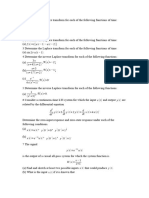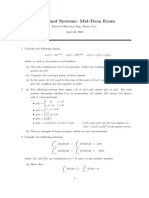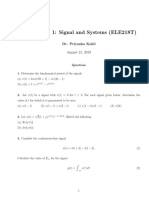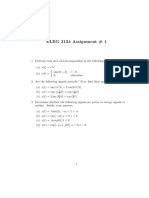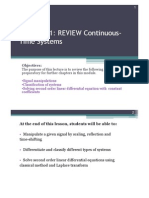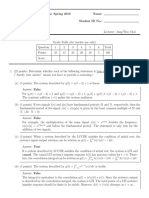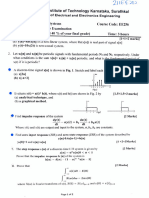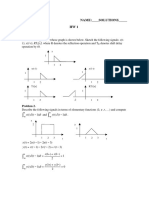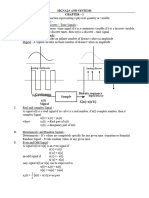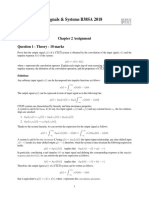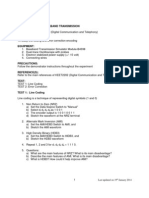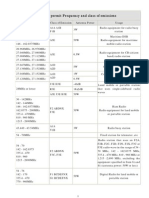Tutorial 1
Uploaded by
Raj GuptaTutorial 1
Uploaded by
Raj GuptaTutorial - 1
ECC201: Fundamental of Communication Systems
1. For the continuous-time signals shown below, sketch and label carefully the following signals respec-
tively:
(a) x (4 − 2t )
(b) x (3t + 1)
Figure 1: 1
2. Determine whether the following signals are periodic or not. If periodic, find the fundamental period.
(a) x (t) = 2 cos(10t + 1) − sin(4t − 1)
(b) x (t) = sin2 (t)
(c) x (t) = sin (2t) + cos (3πt)
3. Determine the value of E∞ and P∞ for each of the following signals:
(a) x1 (t) = e−2t u(t)
(b) x (t) = 2 sin (3πt) + 3 cos (3πt + π/3)
(c) x1 (t) = e− a|t| for a > 0
4. Consider the continuous-time signal:
x ( t ) = δ ( t + 2) − δ ( t − 2)
Calculate the value of E∞ for the signal:
Z t
y(t) = x (τ )dτ
−∞
5. Determine which of these properties hold and which do not hold for each of the following continuous-
time systems. Justify your answers. In each example, y(t) denotes the system output and x (t) is the
system input. In particular, a system may or may not be
1. Memoryless
2. Time invariant
3. Linear
4. Causal
5. Stable
R 2t
(a) y(t) = −∞ x (τ )dτ
(
0, x (t) < 0
(b) y(t) =
x ( t ) + x ( t − 2), x (t) ≥ 0
dx (t)
(c) y(t) = dt
6. Determine and sketch the convolution of the following two signals:
t + 1, 0 ≤ t ≤ 1,
x (t) = 2 − t, 1 < t ≤ 2,
0, elsewhere
h(t) = δ(t + 2) + 2δ(t + 1).
7. (a) Consider an LTI system with input and output related through the equation
Rt
y(t) = −∞ e−(t−τ ) x (τ − 2)dτ.
What is the impulse response h(t) for this system?
(b) Determine the response of the system when the input x(t) is as shown in Figure 2.
Figure 2: 7(b)
Page 2
You might also like
- COSC 3451: Signals and Systems: Yt XT YtNo ratings yetCOSC 3451: Signals and Systems: Yt XT Yt14 pages
- Exercises For Signals and Systems (Part Four)No ratings yetExercises For Signals and Systems (Part Four)3 pages
- Exercises For Signals and Systems (Part Two)No ratings yetExercises For Signals and Systems (Part Two)4 pages
- Midterm Exam Paper No.1: EE2001E: Signals and SystemsNo ratings yetMidterm Exam Paper No.1: EE2001E: Signals and Systems2 pages
- Midterm Exam Paper No.1: EE2001E: Signals and SystemsNo ratings yetMidterm Exam Paper No.1: EE2001E: Signals and Systems2 pages
- Question Bank_231ECC304T_Signals and systems_Answer key_Unit3No ratings yetQuestion Bank_231ECC304T_Signals and systems_Answer key_Unit316 pages
- Problem Set 2 Solution: X (T + 2) 2x (T + 1)No ratings yetProblem Set 2 Solution: X (T + 2) 2x (T + 1)8 pages
- Transmission of A Signals Through Linear SystemsNo ratings yetTransmission of A Signals Through Linear Systems12 pages
- Laplace Transform _ DPP-04 (of Lec- 08 & 09) __ Shreshth GATE 2025 Electrical Weekday (Hinglish)No ratings yetLaplace Transform _ DPP-04 (of Lec- 08 & 09) __ Shreshth GATE 2025 Electrical Weekday (Hinglish)3 pages
- EE 220 - Signals, Systems and Networks Tutorial - 2No ratings yetEE 220 - Signals, Systems and Networks Tutorial - 21 page
- Week 5 - Signal Representations Using Fourier Series Activity 1 Part 1No ratings yetWeek 5 - Signal Representations Using Fourier Series Activity 1 Part 14 pages
- Midterm Exam: Signal and System-100 Minutes Code 0010No ratings yetMidterm Exam: Signal and System-100 Minutes Code 001016 pages
- Full Name: Lab Section: ECE 3500 (Spring 2017) - Examples #1No ratings yetFull Name: Lab Section: ECE 3500 (Spring 2017) - Examples #111 pages
- Systems of Linear Equations: 1 Matrix FunctionsNo ratings yetSystems of Linear Equations: 1 Matrix Functions12 pages
- 2.2 Continuous-Time LTI Systems: The Convolution IntegralNo ratings yet2.2 Continuous-Time LTI Systems: The Convolution Integral12 pages
- EE4440 HW#1 Assignment: January 13, 2011No ratings yetEE4440 HW#1 Assignment: January 13, 20112 pages
- Signals & Systems B38SA 2018: Chapter 2 Assignment Question 1 - Theory - 10 MarksNo ratings yetSignals & Systems B38SA 2018: Chapter 2 Assignment Question 1 - Theory - 10 Marks6 pages
- Telecommunications Technology Fundamentals: III-1 TransmissionNo ratings yetTelecommunications Technology Fundamentals: III-1 Transmission24 pages
- Modelling and Control Strategy For Single Phase Grid Connected PV SystemNo ratings yetModelling and Control Strategy For Single Phase Grid Connected PV System33 pages
- 67 - 5G & Massive MIMO For TEM Co Feb 2019100% (1)67 - 5G & Massive MIMO For TEM Co Feb 2019115 pages
- Symulation of Optical Fiber Communication System With Polarization Mode DispersionNo ratings yetSymulation of Optical Fiber Communication System With Polarization Mode Dispersion114 pages
- Service Schematics: Exploded View and Component DisposalNo ratings yetService Schematics: Exploded View and Component Disposal9 pages
- Ensc 815 Multirate Signal Processing: Jie Liang Engineering Science Simon Fraser University Jiel@Sfu - CaNo ratings yetEnsc 815 Multirate Signal Processing: Jie Liang Engineering Science Simon Fraser University Jiel@Sfu - Ca41 pages
- Floyd The Science of Electronics: Digital 1e Multiple ChoiceNo ratings yetFloyd The Science of Electronics: Digital 1e Multiple Choice7 pages
- Application Note - Using Low Level Metrics On Speedway RevolutionNo ratings yetApplication Note - Using Low Level Metrics On Speedway Revolution16 pages
- Transmission-Asynchrone Synchrone Mode Transmission VFNo ratings yetTransmission-Asynchrone Synchrone Mode Transmission VF38 pages
- Rimedo TheORANWhitepaper TrafficSteeringNo ratings yetRimedo TheORANWhitepaper TrafficSteering52 pages
- RF Power Meter v2: Preliminary Operator's ManualNo ratings yetRF Power Meter v2: Preliminary Operator's Manual10 pages
- Operational Modes: IMO Performance Standard For BNWAS Are As FollowsNo ratings yetOperational Modes: IMO Performance Standard For BNWAS Are As Follows11 pages






